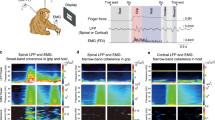Abstract.
The hypothesis put forward here is that simple reaction time (SRT) modulation on the background of an oscillatory motor action is due to central neural coupling between signals to the effectors involved in the focal and the oscillatory action. The strength of the coupling may be defined by various factors ranging from anatomy to personal lifetime practice or to a particular task context. In one experiment, subjects performed an SRT task (ipsi- or contralateral elbow flexion or ipsilateral ankle plantar flexion) in response to a visual imperative signal presented during a continuous oscillatory movement of the right wrist. Discrete elbow movements lead to nearly simultaneous large bursts of activity in both biceps and the wrist flexor of the arm. Strong modulation of premotor time (peak to peak changes of about 80 ms) with the phase of oscillatory action (f osc ) was seen in both biceps and wrist flexor when the two movements were performed by joints of the same limb but not when they were performed by joints of different limbs. The order of recruitment of proximal and distal muscles was also dependent on the phase of oscillatory action: the typical proximal-to-distal order was seen at relatively long premotor times (PMTs) while simultaneous muscle activation was seen at the shortest PMTs. In the second experiment, the subjects held a cylindrical plastic cup in the left hand and applied sine-like isometric force to the bottom of the cup with the other hand. The SRT in the task requiring a quick increase in the grip force in response to a visual imperative stimulus was modulated with the phase of the oscillatory action. This modulation disappeared when the right hand applied similarly modulated force to another surface. The conclusion is that an interaction between control signals for the focal and oscillatory actions at a supraspinal level led to the observed modulation of the SRT during the phase of oscillatory action. The possible role of cortical and subcortical mechanisms is discussed.
Similar content being viewed by others
Author information
Authors and Affiliations
Additional information
Electronic Publication
Rights and permissions
About this article
Cite this article
Latash, M. Modulation of simple reaction time on the background of an oscillatory action: implications for synergy organization. Exp Brain Res 131, 85–100 (2000). https://doi.org/10.1007/s002219900284
Received:
Accepted:
Issue Date:
DOI: https://doi.org/10.1007/s002219900284




